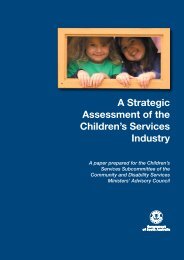Global Study On Child Poverty And Disparities (PDF) - Social Policy ...
Global Study On Child Poverty And Disparities (PDF) - Social Policy ...
Global Study On Child Poverty And Disparities (PDF) - Social Policy ...
You also want an ePaper? Increase the reach of your titles
YUMPU automatically turns print PDFs into web optimized ePapers that Google loves.
Table 2.7: Correlation among deprivation measures, 2007<br />
Bottom asset<br />
quintile Shelter Sanitation Water Information Food Education Health<br />
Shelter 0.466*** 1.000 0.052*** 0.164*** 0.267*** 0.005 0.163*** -0.017<br />
Sanitation 0.041*** 0.052*** 1.00 -0.023* 0.057*** 0.097*** 0.091*** 0.070***<br />
Water 0.236*** 0.164*** -0.023* 1.000 0.130*** -0.034 0.060*** 0.030<br />
Information 0.429*** 0.267*** 0.057*** 0.130*** 1.000 -0.044* 0.098*** -0.003<br />
Food 0.014 0.005 0.097*** -0.034 -0.044* 1.000 n/a 0.016<br />
Education 0.148*** 0.163*** 0.092*** 0.060*** 0.098*** n/a 1.000 n/a<br />
Health 0.022 -0.017 0.070*** 0.030 -0.003 0.016 n/a 1.000<br />
Source: MICS 2007.<br />
* significant at 10% level; ** significant at 5% level; *** significant at 1% level.<br />
Table 2.7 shows the correlation between different<br />
deprivation measures, and between deprivation<br />
and asset quintile. Shelter and information<br />
deprivation are strongly correlated with being<br />
in the bottom asset quintile, with correlation<br />
coefficients being over 0.40, and the correlations<br />
are statistically significant. In contrast, food and<br />
health deprivation are only weakly correlated with<br />
assets, and the correlations are not statistically<br />
significant. This is likely to reflect the fact that<br />
these deprivations are relatively common in Port<br />
Vila, where people have higher levels of assets<br />
but still experience these specific deprivations.<br />
While the correlations between many other<br />
deprivations are statistically significant, the<br />
degree of correlation is not particularly high, and<br />
no deprivations except information deprivation<br />
have correlation coefficients over 0.20. In<br />
brief, the lack of high correlations between<br />
deprivation measures, like the apparent small<br />
number of people experiencing multiple severe<br />
deprivations, suggests that while deprivations<br />
may be reasonably common, entrenched multiple<br />
deprivation does not exist. Around 4 per cent of<br />
children experience multiple deprivations, which<br />
is similar to the proportion of children living in<br />
the most severe expenditure poverty (under<br />
$1.08 per day). Because these two indicators are<br />
derived from different surveys, it is not possible<br />
to check whether those with the lowest levels of<br />
expenditure are also those experiencing multiple<br />
deprivations, but this coincidence suggests that is<br />
a possibility.<br />
Summary of deprivation findings<br />
As with the analysis of expenditure poverty, the<br />
analysis of deprivation shows that disparities<br />
in child well-being have important dimensions<br />
related to location. Torba and Tafea have the<br />
highest expenditure poverty rates and the highest<br />
poverty gaps (using a national-level poverty line),<br />
and they have the highest rates of deprivation.<br />
However, based on sub-national poverty lines,<br />
Port Vila has the highest poverty rate, as well as<br />
the highest levels of food and health deprivation<br />
for children.<br />
Many of the other factors associated with higher<br />
poverty rates are also associated with higher<br />
deprivation risks. For example, households<br />
where the head has no schooling have child<br />
poverty rates that are 3.7 times those of<br />
households where the head has a secondary<br />
school education; the corresponding ratio for<br />
severe deprivation is 3.4 to 1. The gender of<br />
the household head is unimportant both for<br />
expenditure poverty and deprivation. Household<br />
size has broadly similar effects for both measures<br />
of well-being, as does the presence of a person<br />
70 years or older in the household.<br />
52
















